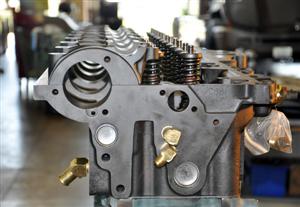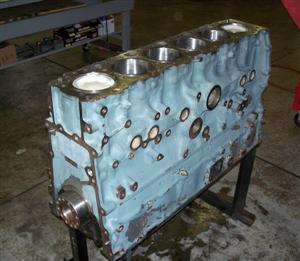July 2009 - Performance Zone
THE PERFECT DETROIT
By Performance Specialist Bruce C. Mallinson
We find that most of our 10-4 readers are passionate owner operators. Because of that fact, we thought you might like to see some photos of how we build our Detroit Diesel engines (photos that wouldn’t be possible without some “camera guidance” from Dan at 10-4). We are now building our 3rd Signature Series DD4, and we are seeing great results from the first two.
Our first Signature Series Detroit DD4 engine, installed in Kevin Rutherford’s first Signature Series Glider Kit, is now running between northern Utah and Seattle up I-84 hauling 80,000 lbs. and averaging 8.3 mpg. Our goal is 9 mpg, so we are going to make two changes to this Freightliner. Keep in mind that this truck has a single drive axle and a tag axle, 2.64 gear ratio, a 10-speed direct transmission and super single tires. The ECM was originally set for 470 hp with a top RPM of 1,800.
To obtain 9 mpg, we have decided to convert the transmission to a single overdrive 13-speed, not to run it in overdrive but to have the ability to split a gear (with the 2.64 gears the truck will drive normally in direct gear). Next, we will set the ECM to 2,200 rpm and 550 hp. Remember, this is an experimental truck that was originally set up to run on level terrain. Being that it’s running in the mountains, we feel that these two changes will render a 9 mpg semi truck. If the truck was hauling lighter loads, the tag axle could be raised more often and the 9 mpg we are seeking would be easier to obtain, however it’s hauling 80,000.
We are currently building our 3rd DD4 Signature Series engine. One of the photos shows the engine block with the ceramic and Teflon coated two-piece steel top pistons installed. This block has been hot tanked, line bored, resurfaced, counter bores cut, and the liner protrusion has been set at .004 to better hold the head gasket. This block is better than new because its “seasoned” which means all of the warpage (twisting of the block) is now gone. Back in the 1960’s and 1970’s, race car builders always built used engine blocks for their cars because a new block would warp. It’s a fact that a cast iron block that is four feet long will warp after a period of miles.
This fact about warpage is also why crankshafts become bent after several years of hard work. Because of this, all our crankshafts are straightened, magnafluxed and polished. During our 31 years building high performance diesel engines, NONE of our refinished crankshafts have ever failed. Once the engine block has been line bored and the new main bearings installed, the crank is installed and the main bearing caps are torqued. At this point, all you need is one hand to rotate the 380 lb. crankshaft. That is perfection, engine longevity, fuel mileage and long bearing life.
 The other picture is a close-up shot of a Pittsburgh Power remanufactured head. After the head is disassembled, hot tanked and magnafluxed for cracks, it is resurfaced and the camshaft bore is honed to make it straight. Then, it is fitted with new valves, new valve guides, new valve seats, new valve springs (with 10 lbs. more pressure), new retainers, new keepers, new coppers in the injectors and new cam bearings. At this point, it is better than new, because it won’t warp anymore. It is also better than a Detroit reman head because the valve springs they use are not as strong, and they will reuse valves, even if they are at the minimum for thickness. This is just a few of the things that make up a Signature Series Pittsburgh Power engine (we will discuss some of the others in future articles).
The other picture is a close-up shot of a Pittsburgh Power remanufactured head. After the head is disassembled, hot tanked and magnafluxed for cracks, it is resurfaced and the camshaft bore is honed to make it straight. Then, it is fitted with new valves, new valve guides, new valve seats, new valve springs (with 10 lbs. more pressure), new retainers, new keepers, new coppers in the injectors and new cam bearings. At this point, it is better than new, because it won’t warp anymore. It is also better than a Detroit reman head because the valve springs they use are not as strong, and they will reuse valves, even if they are at the minimum for thickness. This is just a few of the things that make up a Signature Series Pittsburgh Power engine (we will discuss some of the others in future articles).
Cody Fend, the young two-year-old boy who was born blind from Butler, PA that I did an article about almost two years ago and asked all of you who read these articles to please send $1.00 to the Cody Fend Fund can now see! Because of you, the owner operators of North America and a few trucking companies, we were able to help raise $60,000 to send Cody and his parents to China to have stem cells placed in his optic nerve. Several owner operators donated $500 and one generous trucking company sent in $2,000.
Cody, who is now almost four years old, is attending the Pittsburgh School for the Blind and can tell you the color of boats traveling along the Allegheny River, play games with his parents, watch television, knows all of the colors and talks all the time about what he sees. Because President Obama recently gave the okay for stem cell research in the USA, Cody will now be able to get more treatments right here in our own country. We have some pictures of Cody standing on the wheel of a Peterbilt when he was blind – maybe we could get new pictures of him with sight and let him see some of the beautiful trucks in our shop. To all of you that contributed, we thank you, and so do Cody and his family!
If you like what we do and what we stand for here at Pittsburgh Power, we’d appreciate your business. We realize it is tough right now, and that your business keeps us in business. We want to be around for another 31 years to continue helping owner operators. If you have questions, I can be contacted at (724) 360-4080 or via e-mail at bruce@pittsburghpower.com.
